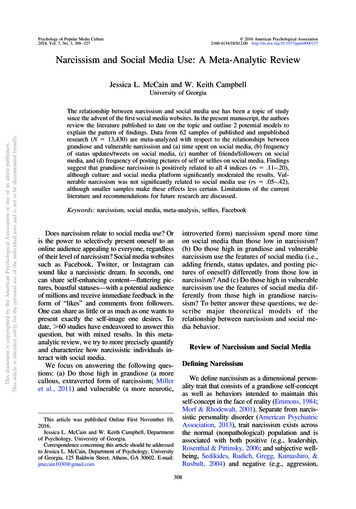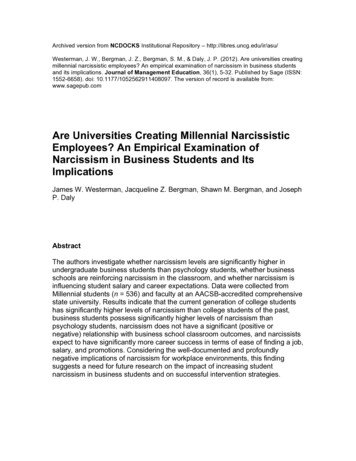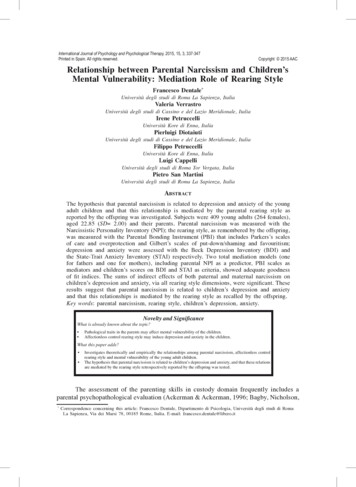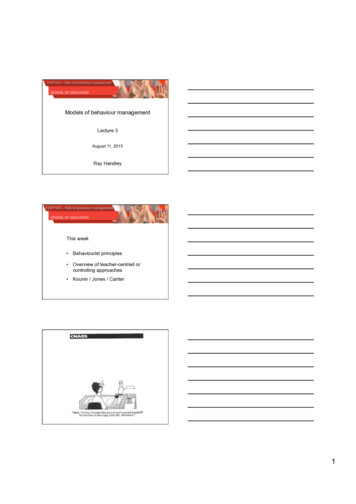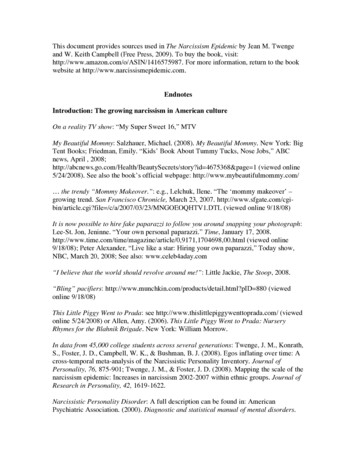
Transcription
NARCISSISTIC BEHAVIOURA COMPILATION OF ARTICLES.Authored by: Christine Louis de Canonville
Narcissistic Behaviour - Compilation of ArticlesBy Christine Louis de Canonville 2012 August Copyrighted Content by Christine Louis de Canonville . All rights reserved.Cover design and layout byPhotographs byAll rights reserved. No part of this EBook may be reproduced or transmitted in any form, by any means,electronic or mechanical, including photocopying or recording or by any information storage or retrievalsystem, without express permission in writing from the author, except where brief passages are quotedfor the purposes of review. Please do not participate in or encourage piracy of copyrighted materials inviolation of the author’s rights. Purchaseonly authorized editions.1st Edition Published 2012 byChristine Louis de CanonvilleDublin, Ireland.Website: www.narcissisticbehavior.netAlthough the author has made every effort to ensure the accuracyand completeness of information contained in this EBook, I assume noresponsibility for errors, inaccuracies, omissions, or any inconsistency herein.Any slights of people, places, or organizations are unintentional.First edition printed August 2012Compilation of Essays by Christine Louis de CanonvillePage - 1 -
Contents of Articles:Page0. INTRODUCTION .41. THE NARCISSISM EPIDEMIC .The “Me First” Culture 52. WHAT EXACTLY IS NARCISSISM? 83. 10 INSIGHTS TO UNDERSTANDING NARCISSISTICPERSONALITY DISORDER .214. NARCISSISTIC VICTIM SYNDROME (A New Diagnosis?) . .275. NARCISSISTIC VICTIM SYNDROME: What the heck is that? .296. NARCISSISTIC VICTIM SYNDROME FROM A SHAMANICPERSPECTIVE .427. RECOGNIZE NARCISSISTIC TRAITS BEFORE IT IS TOO LATE. 488. REVEALING THE TWO FACES OF NARCISSISM: Overt andCovert .539. THE EFFECTS OF GASLIGHTING IN NARCISSISTIC VICTIMSYNDROME 5710. IS THERE A RELATION BEWTWEEN NARCISSISM ANDSHAME? 7111. UNDERSTANDING THE PHENOMENON OF INFANTILEREGRESSION IN RELATION TO NARCISSISTIC VICTIMSYNDROME . 8012. NARCISSISM AND THE ADDICTION TO “SELF” . 8413. NARCISSISM AND THE ADDICTION TO NARCISSISTICSUPPLY . 89Compilation of Essays by Christine Louis de CanonvillePage - 2 -
Contents of Articles Con’t:Page14. THE NARCISSISTS ADDICTION TO ADRENALINE . 9415. THE NARCISSISTS ADDICTION TO FAME . 9716. THE NARCISSISTS ADDICTION TO GRANDIOSITY . 10017. RECOGNISE NARCISSISTIC TRAITS BEFORE IT IS TOO LATE . 10418. WHAT DOES THE BIBLE SAY ABOUT NARCISSISTICBEHAVIOUR?. 10919. CAN WOMEN BE NARCISSISTIC? 12020. THE TYPICAL NARCISSISTIC WOMAN AS A FRIEND . 12421. THE PLACE OF "COGNITIVE DISSONANCE” IN NARCISSISTICVICTIM SYNDROME . 12722. THE FOUR COMPONENTS OF NARCISSISTIC GRANDIOSITY 13423. THE PLACE OF MYTHS FOR THE UNDERSTANDING OFNARCISSISTIC PERSONALITY DISORDER . 13724. UNDERSTANDING NARCISSISTIC PERSONALITY DISORDERAND NARCISSISTIC INJURY . 14225. DO YOU UNDERSTAND THE PHENOMENON OF NARCISSISTICSUPPLY?. 14526. WAS RAOUL MOAT A NARCISSIST? . 146Compilation of Essays by Christine Louis de CanonvillePage - 3 -
IntroductionThis EBook, has been put together as a direct result of the many requests I havereceived from numerous readers of my site, (The Roadshow for Therapists). Itseems that many therapists and other readers felt that having a book that theycould download, and read at their leisure on their computers or electronic readerswas more conducive to their needs for studying.This little EBook is much more that a compilation of the 26 Research Articles thatI wrote and posted on my site for the specific purpose of informing other therapistson the subject of Narcissistic Personality Disorder, that includes the effects of thatform of abuse on the victims. Many victims, especially those who were exposed tolong term abuse in their childhood often find themselves suffering from a range ofsigns and symptoms that I refer to as Narcissistic Victim Syndrome.What follows is the result of many years of experience working as apsychotherapist, four years of which was working in a post traumatic stressDisorder Unit within a psychiatric hospital. Within these pages I echo the manyvoices of other researchers who have struggled to make sense of this subjectmatter, and also share their own lived experiences of abuse. Of course, thelearning is mostly a result of my own journey of abuse and recovery back from themadness of growing up with a narcissist psychopathic sibling. It is not myintention that this EBook speaks for others, but I certainly hope that it will speak toothers in a way that is part of a greater pool of collective experience, knowledge,and consciousness. In many ways it is a spiritual journey of the soul for thehealing of inner hurts caused by mental, emotional, physical and spiritual abuse.Compilation of Essays by Christine Louis de CanonvillePage - 4 -
Article 1:THE NARCISSISM EPIDEMIC .The “Me First” CultureThe 21st Century has brought with it a relentless Narcissism Epidemic causing arise in unhealthy narcissistic traits into our culture. These traits can be found inevery strata of society, with a marked shift especially amongst the normalpopulation, and in the numbers of women presenting with narcissistic behaviors.For that reason it is vital that therapists educate and familiarize themselves with allthat is involved in narcissistic behaviors so that they can recognize the destructionand long-term consequences of this narcissism epidemic on society at large.It is also important for therapists to know that this Narcissism Epidemic has givenrise to a new syndrome which has been coined “Narcissistic Victim Syndrome.”This form of repeated narcissistic abuse is now being recognized as having longlasting pernicious and traumatic effects on the mental health of the victims.Unfortunately, most therapists have never heard of this syndrome, yet it is cominginto the therapy room every day. Through no fault of their own, therapists are illequipped to recognize or work effectively with these clients, as this training is nottaught on Professional Training Courses as yet. Narcissistic Personality Disorder isrelatively new on the scene. Since the 1980’s all the research was pointed towardsthe narcissist themselves, and treatment of these patients meant that they wentthrough psychiatric and Mental Health Services. It is only now that the effects onthe victims are being researched. And of course, most victims do not go throughthe psychiatric system; they are much more likely to enter into a psychotherapeuticprocess because they have no idea what-so-ever that they are victims of narcissisticabuse.As well as being educated in Narcissistic Victim Syndrome, therapists also musteducate themselves in the area of the Narcissism Epidemic Traits, and NarcissisticPersonality Disorder. I would consider this vital for working effectively with thevictims of narcissistic abuse, without this knowledge you will have no idea of whatyou are dealing with. Narcissistic Victim Syndrome goes way above the normalrange of the abuse therapists are trained to work with. To complicate matters, manyCompilation of Essays by Christine Louis de CanonvillePage - 5 -
of the victims present with Post Traumatic Stress Syndrome (PTSS) symptomsresulting from years of mind control, and coercion. These conditions result from avictims bonding and emotional connection to their narcissistic abuser (TheStockholm Syndrome). These are the same symptoms that are often seen inprisoners of war, hostages, and cult members. Therapists must realize that thesevictims have lived in an environment that resembles a war zone, and in order tosurvive the horrendous abuse, they had to learn how to enter into the convoluteddance of the narcissist. This conditioning (like Pavlov’s dogs) is unconscious,tucked well away from conscious awareness, priming them for further revictimization if not properly addressed. Re-victimization is a phenomenon of thissyndrome.There is no need for therapists to panic, already they have many of the attributesnecessary for working with this condition, they just need to add to their knowledgeby educating themselves in this new syndrome and understand the maladaptivebehaviours of the narcissist. In return, they then become educators to the victims sothat they can begin to make sense of how this abuse has happened to them. Youcan help them quit from being victims and become empowered once again. Ofcourse, they will need time and a safe place to grieve for their numerous losses andshame that they have suffered. Room also needs to be made for the expression ofany anger that is triggered. As the victim moves through their story, they will havea greater understanding of their own survival behavior, and the intelligence at playbehind that behavior. Working in this way will build the clients self-worth, selfesteem, and help them to regain their personal power. Often the victim is perplexedas to how they put up with so much abuse without doing anything about it, whatthey need to understand is that they did the best they could at the time, which wasin reality using their “survival tactics”, no matter how mad it seems to them now.In time they will learn how to protect themselves from being victims, to quitblaming themselves for all that’s wrong in their relationships, to gain acomprehensive knowledge of the Narcissism Epidemic and Narcissistic Disordersso they will never again become re-victimized by another narcissist. If therapistsdo not complete the process work, they fail their client, because they leave themvulnerable to more re-victimization, not just in their homes, but from othernarcissists they come into contact with, for example, friends, and work colleagues,bosses etc. Narcissists spot those victims who know their convoluted dance in anCompilation of Essays by Christine Louis de CanonvillePage - 6 -
instant, and they become like moths to the flame, which is an irresistible anddangerous attraction that truly excites the narcissist in his hunt for narcissisticsupply.Compilation of Essays by Christine Louis de CanonvillePage - 7 -
Article 2What Exactly is Narcissistic Personality Disorder?Explaining the Many Facets of Narcissism!Narcissistic Personality Disorder, what exactly is it? Trying to explain exactlywhat narcissistic personality is takes some doing, the reason being that there are somany facets of behaviour involved. However, Narcissism, roughly translatedmeans “love of oneself”. The term itself refers to a set of character traits thatinvolve self-admiration, self-centeredness, and self-regard; to the point where thenarcissistic person becomes very grandiose, arrogant, aggressive, lacking inempathy for others, superior to everybody else, and sporting a sense of entitlementthat leaves them in constant need for attention and admiration in all theirrelationships. The term was coined by Sigmund Freud who picked the myth ofNarcissus as a symbol of a self-absorbed person whose libido is invested in the egoitself, rather than in other people. There are several versions of the myth, butroughly translated Narcissus, in Greek mythology, was a beautiful Greek boy whofound himself to be so attractive, that he falls in love with his own reflection. Theterm narcissistic personality disorder, also taken from the myth, describes a selfloving character with grandiose feelings of uniqueness.The Spectrum of Narcissism is on a Continuum.Narcissism is a spectrum of behaviour that is prevalent in the human conditionuniversally. What this means is that we are all narcissistic to a degree, and thenarcissistic traits can range on a continuum from 1 – 10, from what we call HealthyNarcissism (being a 1), all the way to a pathological form, called NarcissisticPersonality Disorder or NPD (being a 10), with varying degrees in between.When narcissism reaches a stage called “Malignant Narcissism” the personconsistently manifests at least 5 of the 9 criteria necessary to put it into thecategory of being a mental disorder.Compilation of Essays by Christine Louis de CanonvillePage - 8 -
To the casual observer, telling the difference between a normal range narcissisticpersonality and a narcissistically disordered personality may not be very evident tobegin with, because the difference is the difference between the individuals“intentions”. The healthy narcissistic personality operates from a place of goodwill towards another person, while the unhealthy malignant disordered personalityoperates from a place of ill will towards another person, which naturally enoughputs a chasm between them.Healthy Narcissism Style V’s Unhealthy Narcissism:Every human being craves approval. This need for approval is driven by the ego inorder to make us feel loved, important, powerful and in control, and perhaps evenmore importantly, to steer us away from any criticism, which can lead to feelingsof inferiority. Adler (psychologist) believed that it was the pain of inferioritythat motivated all human action to strive for a sense of superiority and perfection.This is natural, and is healthy narcissism in action, a normal defense that isessential for psychological health. It is this action that protects us from painfuldisappointments, failures, and keeps us away from feelings of helplessness. Thisboosting of our morale (Healthy Narcissism) is what motivates us to do better withour lives.Healthy Narcissism:However, with regard to narcissism, our structure of psychological well-beingrequires balance if it is to stay healthy; too little narcissism can be just aspathological as too much. Too little sense of narcissism leads to a lack ofconfidence and esteem. Without confidence and esteem we become fearful, andthis exposes us to feelings of inferiority; whereas too much (UnhealthyNarcissism), we risk the likelihood of having inflated egos, and putting ourselvesin danger where we may compromise social cohesion in order to make ourselvesstand out. However, when one is balanced they have a healthy narcissism drivingtheir ego forward. The person sports a confident attitude where they are aware oftheir strengths and weaknesses of their personality, and they have both the negativeand positive aspects available to them. Because they “know their selves” they areable to have realistic expectations of their self, and their expectations fitcomparatively with their abilities. They are fully aware of being separate fromCompilation of Essays by Christine Louis de CanonvillePage - 9 -
others, and they have faith in their own set of ideas and ideals. They use theirhealthy narcissism in a way that channels them in the direction of getting theirneeds meet, without having to disrespect or harm anybody else in the process. It isin this healthy or mature narcissism that there is balanced giving and taking, and itis this balanced giving and taking that allows a person to enter into mutuallysatisfying relationships that last the test of time. In this space there is a healthyrespect for both the giver and the receiver to retain their uniqueness andindependence with each other. Both are equal, so there is no need for any “oneupmanship” or “one-downmanship” in the relationship. Unhealthy narcissism onthe other hand is in complete contrast.Unhealthy Narcissism:Where there is unhealthy narcissism, the individual manifests their behaviorthrough a personality disorder, and therefore they are incapable of having a truereciprocal bond in any relationship. They will operate through either onedownmanship (the practice of outdoing others in a negative way), or oneupmanship (the practice of any assertion of superiority). For example, their needfor one-downmanship is used when they have a need to idealize someone; whereastheir one-upmanship is present when they need another person as a mirroring selfobject (narcissistic supply) in order to confirm their specialness for them. Thisdoes not usually last long, because all self-objects are eventually devalued oncethey have lost their functional one-upmanship. They are then held in contempt,and discarded after their usefulness is used up. It is nothing personal, it is how theunhealthy narcissist treats everybody; he/she uses, abuses, and discards, then goeson to the next victim with no remorse what so ever.The Narcissists Intolerance to Shame:Because individuals with a true Narcissistic Personality Disorder are contemptuousand shameful of the less-than-perfect aspects of themselves, they cannot toleratethose same aspects in others. Any flaws that they see in another are likely tomirror back their own flaws, and that enrages them. At this point their narcissismhas ceased to be a source of healthy self-respect and self-esteem, but rather, it hasbecome a defense of a false grandiose self that needs to be guarded against painfulfeelings of shame and low self-worth if it is to survive. It is shame or humiliationCompilation of Essays by Christine Louis de CanonvillePage - 10 -
that is always the underbelly or the driving force behind their narcissistic defenses.Neurotic shame is the root cause of the narcissist’s multi-addictions. AlcoholicsAnonymous has long recognized that it is the individual’s grandiosity, selfcenteredness, and lack of humility that are the most difficult obstacles to overcomein addictions. False-pride, inflated ego and grandiosity are viewed as defensesagainst feelings of inferiority and inadequacy. One has to inflate against theintolerable effects of shame which of course is the cornerstone of the narcissist’spsychopathology. Pathological narcissism occurs in a spectrum of severity. In itsmore extreme forms, it manifests itself as Narcissistic Personality Disorder (NPD).DSM IV-TR: The Diagnostic and Statistical Manual of Mental Disorders.The American Psychiatric Association brought out a manual that covers all mentalhealth disorders for both children and adults. This Diagnostic and StatisticalManual of Mental Disorders (or DSM IV-TR as it is better known) is consideredthe bible of psychiatrists, psychologists and other mental health professionalseverywhere, and it specifies the nine diagnostic criteria for identifying narcissisticpersonality disorder (NPD). By the way, this manual is constantly being updated asmore about the condition of narcissism is understood. At present, for the clinicianto make the diagnosis, an individual must fit five or more of the following ninedescriptions:Narcissistic Personality Disorder Criteria:1. He or she has a grandiose sense of self-importance (exaggeratesaccomplishments and demands to be considered superior without realevidence of achievement).2. He or she lives in a dream world of exceptional success, power, beauty,genius, or “perfect” love.3. He or she thinks of themselves as “special” or privileged, and that he or shecan only be understood by other special or high-status people.4. He or she demands excessive amounts of praise or admiration from others.5. He or she feels entitled to automatic deference, compliance, or favorabletreatment from others.6. He or she is exploitative towards others and takes advantage of them.Compilation of Essays by Christine Louis de CanonvillePage - 11 -
7. He or she lacks empathy and does not recognize or identify with others’feelings.8. He or she is frequently envious of others or thinks that they are envious ofhim or her.9. He or she “has an attitude” or frequently acts in haughty or arrogant ways.Characteristics of Destructive Narcissism:As humans we are called to live as a real or authentic self, that is, to live fullyconscious through the True Self. For the narcissist this is not possible, becausetheir True Self has been banished since childhood, because sadly, it was unable tocope with its painful world. Instead, the narcissist installs a proxy for the True Selfwhich serves to protect it; this self is referred to as a False Self. The False Self isquite a tyrannical and grandiose self that can bat off huge amounts of pain, givingthe narcissist immunity from further hurt. Sam Vakin describes it well when hesays, “the False Self is a cloak, protecting and rendering the narcissist invisible andomnipotent at the same time”.The narcissist’s attachment to his grandiose false-self accounts for the first threeattributes in the DSM-IV’s checklist for NPD shown above (i.e. their sense of selfimportance, exaggerated accomplishments, superiority, powerfulness, genius, andspecialness). At the core of the malignant narcissist is the creation of a grandioseFalse Self, not a healthy True Self. Therefore, just as in the Myth of Narcissus,the narcissist is in love with their reflected self, (a counterfeit version of the trueself) that is superior and perfect. Having rejected their true self, the narcissistinvests excessive love in an illusionary fantasy self to which they are besotted.Disordered narcissists consider themselves to be unique and superior to others,they possess a grandiose view of their own self-importance. Their grandiosity goesbeyond mere boasting; it is more a self-aggrandizement, which is not borne out byreality. They maintain their grandiose self by fantasying internally about fame,wealth and power; and externally by defending themselves from criticism, shameand humiliation. Their superiority complex is really a response to their feelings ofinferiority.Compilation of Essays by Christine Louis de CanonvillePage - 12 -
The hallmark of the narcissist is their grandiosity:The Narcissist’s grandiosity can be seen in the way they exaggerate their sense ofself-importance with regard to their family, their work, their “anything” in fact.They give the impression that everybody they have to deal with is useless (theirspouse, their family, their co-workers, their friends, etc.). Wherever there issuccess, naturally, it is due to them, because (according to them) everybody else isundependable, unskilled, or just not up to par with them. In their world they arethe hero, and if it were not for them, their family would be in the gutter, thebusiness would not function, and everything would be a disaster. Their motto is “Iam the greatest”. The truth is that they expect others to do the day-to-day chores asthey feel too important to waste their time on common things. It is their families(or others) that do the lion’s share of the work, they are in effect high maintenance,and yet they complain that they have to do everything. Of course, this selfsacrifice gets them a good deal of attention and respect from those who do notreally know them.Narcissist as pathological liar:Narcissists are apt to tell lies, and when they get away with them, they think theyare clever and superior. They often use lies in order to manipulate people, and toset up people against each other. You may never catch them out in their grandioselies, unless you work with them, or visit them in their home. Then you will reallysee how much others do pull their weight, and carry the narcissist’s share as well.You may also be very surprised to find that this wonderful fun loving individual isreally a bully when at home (home being really anywhere they feel they are incontrol). Often their grandiosity will seep into religious ideology, where theybelieve that they have been specially chosen by God, therefore exempt from therules that other plebs have to adhere to. When they do pull on religion to gaincontrol, you are likely to find out that the rules are much harsher for you than forthem. For example, you will be the one to make the pilgrimage to the top of themountain (physically or metaphorically speaking), while they wait at the bottom ina nice warm place while waiting your return. They always get others to do thelion’s share of the work, and their dirty work.Compilation of Essays by Christine Louis de CanonvillePage - 13 -
The narcissist’s self-esteem:The narcissist unstable self-esteem constantly craves love, attention and admirationfrom other people. Just like a child, they are unable to take their sense of selfesteem from within their own self; they look outside themselves to others in orderto have their self-esteem mirrored to them. Their demands are so insatiable thatthey will constantly seek narcissistic supply in order to boost their self-esteem, andmeet their constant demand for attention. Their assessment of others is always interms of their usefulness to them, and they are likely to fly into a rage when theirdemands are not met. All of their relationships start out by the unrealisticidealization of the other person. At first the individual is put on a pedestal of dizzyheights, but before long they will find that they are not able to meet the unrealisticexpectation of the narcissist, and they will topple off that pedestal with a bump.Once disappointed in the person who has been chosen to be their source of supply,the narcissist perceived the disappointment as a threat to their self-esteem or selfworth, causing them a “narcissistic injury”. Any narcissistic injury (real orimagined) reminds them of their shame and “self-loathing”. Whenever thishappens, their rage will be triggered, and without warning they will very soonexploit and devalue the person without any remorse. The narcissist ishypersensitive to any rejection or criticism, no matter how mild. It is their unstableview of themselves that cause them to fluctuate between two extremes; the extremeof self-praise, and the extreme of self-contempt. Because they cannot tolerate theirextreme feelings of self-contempt, they set about creating an illusion of superiorityin order to compensate for their feelings of inferiority, and they will even lie abouttheir achievements and accomplishments (to themselves) in their bid to build uptheir image of high self-esteem, so that they can self-praise, and feel safe onceagain.The Narcissist lacks empathy:Empathy is the ability to infer and experience another’s emotions. The narcissisthas disturbances in their capacity for empathy, so they don’t know what othersvalue or why. That is why they have a history of intense, yet short-livedrelationships. Actually, they seem to have an inability to make or sustain genuineintimate friendships. The pathological narcissist’s lack of empathy is a directCompilation of Essays by Christine Louis de CanonvillePage - 14 -
result of their grandiosity; however, even though they lack empathy, they are adeptat faking it when they need to convince someone that they really do care. They aremasters of using pseudo empathy in order to manipulate others (narcissistic supply)into getting what they want, and they will use other people to get what they wantwithout caring about the cost to those people. In fact, they seem to have aninability to recognize and accurately interpret other people’s emotions.Their lack of empathy and fear of rejection colors everything that they do. Forexample, they avoid intimate relationships because of their “rejection sensitivity”.Attachment in an intimate partnership is frightening for them, because it makesthem too vulnerable to the pain of rejection. Their rejection sensitivity originatedin childhood as a self-protective reaction to rejection by primary care-givers, andthis reaction continues into adulthood, where it undermines all of theirrelationships; causing them to fear intimacy. The narcissist experiences high levelsof anxiety because they always expect others to reject them, so they self-protect byavoiding intimate relationships. Unfortunately, their fear of rejection becomes aself-fulfilling prophecy, because (due to their behaviour) they often find thatpeople do reject and leave them. When a relationship appears to be going well,they become scared by the level of intimacy they are receiving, and they abort therelationship with no consideration for the other person. It seems that they prefer tofirst reject rather than risk being rejected.Narcissistic envy:Narcissists are plagued with feelings of envy. These feelings of envy are derivedfrom their sense of low self-esteem. Envy is not jealousy. Jealousy is the fear oflosing something that one already possesses to another person (i.e. losing a lovedone to a rival); while envy is the pain or frustration of not having what anotherperson has. Envy involves two people, the envier and the rival. So when thenarcissist (the envier) sees someone (the rival) possessing something that they donot have (materially, psychologically, mentally etc.), it provokes in them feelingsof inadequacy, and triggers their resentful longing. When they experience such a“lack” in themselves, it causes them to feel mortified, shamed and inferior, thesedistorted feelings causes them to experience another narcissistic injury. Thenarcissist reacts in different ways to their distorted feelings than the rest of us; forCompilation of Essays by Christine Louis de CanonvillePage - 15 -
example, their reactions can be carried out through methods of modeling,devaluing, cognitive dissonance, or avoidance behaviour. All of these mechanismsprotect them against their distorted feelings.Modeling and devaluing:Because of their fragile ego’s, narcissists generally want to hang around withpeople they consider to be inferior to them, usually those with an averageintelligence that they can control. That way they can be seen to be a superiorgenius, (a God Complex) where everybody else is inferior. This behaviour strokestheir ego, and makes them feel special. However, from time to time, the narcissistfixates on someone whom they perceive as having a higher intelligence thenthemselves. They can see that this person possesses something
As well as being educated in Narcissistic Victim Syndrome, therapists also must educate themselves in the area of the Narcissism Epidemic Traits, and Narcissistic Personality Disorder. I would consider this vital for working effectively with the victims of narcissistic abuse, without this kn

